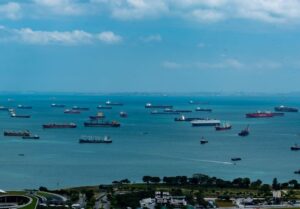 In last month’s report, I pointed out that one of the reasons for the increase in ocean freight and the shortage of containers was the slow handling of containers in the West Coast ports of North America, especially in the ports of Los Angeles and Long Beach. Then, the volume of import containers unexpectedly increased due to increasing consumption from staying at home. As of Aug. 26th, there were 38 vessels waiting for berth in the two ports, and in some cases, it took up to nine days for berthing. However, in the first week of September. (Aug. 30th – Sep. 3rd), both ports managed to handle 171,525 TEUs, which is 1.74 times from 98,667 TEUs in the previous week. Is this the result of increased productivity due to the dockworkers coming back to the field after the increased number of vaccinations against COVID-19? Have they started to cope with this matter seriously? I am hopeful that they can do it. However, the standby time due to the shortage of chassis and trucks at major inland rail terminals in the U.S. has not been resolved yet, and the confusion is expected to continue for a while. It is a National Day vacation in China in early October, and, just before that, there usually is a cargo rush in September. What will happen then to the West Coast ports of North America?
In last month’s report, I pointed out that one of the reasons for the increase in ocean freight and the shortage of containers was the slow handling of containers in the West Coast ports of North America, especially in the ports of Los Angeles and Long Beach. Then, the volume of import containers unexpectedly increased due to increasing consumption from staying at home. As of Aug. 26th, there were 38 vessels waiting for berth in the two ports, and in some cases, it took up to nine days for berthing. However, in the first week of September. (Aug. 30th – Sep. 3rd), both ports managed to handle 171,525 TEUs, which is 1.74 times from 98,667 TEUs in the previous week. Is this the result of increased productivity due to the dockworkers coming back to the field after the increased number of vaccinations against COVID-19? Have they started to cope with this matter seriously? I am hopeful that they can do it. However, the standby time due to the shortage of chassis and trucks at major inland rail terminals in the U.S. has not been resolved yet, and the confusion is expected to continue for a while. It is a National Day vacation in China in early October, and, just before that, there usually is a cargo rush in September. What will happen then to the West Coast ports of North America?
According to the National Retail Federation (NRF), results for the first half (January-June) of this year totaled 12.8 million TEUs, 35.6% up from the same period last year. The results and forecast for the second half (July-December) are as follows: July: 2.22 million TEUs, 15.7% up y/y; August: 2.37 mil TEUs, 12.6% up y/y; September: 2.21 mil TEUs, 4.9% up y/y; October: 2.15 mil TEUs, 3% down y/y; November: 1.57 mil TEUs, 1.5% down y/y; December: 2.02 mil TEUs, 4.1% down y/y. For the whole year of 2021, it is expected to reach 25.9 mil TEUs, 17.5% up from the previous year.
According to the August employment data released by the U.S. Department of Labor on Aug. 3rd, the number of nonfarm workers increased by 235,000. The number was significantly lower than the market forecast of 720,000, but the number of workers is expected to rise as the federal government’s special supplement of $300 per week to unemployment benefits expires on Sep. 4th. The unemployment rate was 5.2%, an improvement of 0.2% from the previous month.
I would like to focus on the Purchasing Managers’ Index (PMI) for August released by HIS Markit on Aug. 23rd. If the PMI is above 50, the economy is fine, but the PMI is falling down in the U.S. and Europe. The PMI for the U.S. was 55.4 in August, 4.5 points down from July, and the third consecutive monthly decline since May. The Eurozone PMI was 59.5, 0.7 points down from July.
 The global economic downturn has been caused by the worldwide abnormal weather conditions in this summer, as well as the the production suspension of related products due to the shortage of semiconductors. The latest damage was caused by Hurricane Ida, which hit the southern part of the U.S. in early September and brought record-breaking rainfall to the eastern part of the country. The New York City subway system was flooded and the states of New York and New Jersey declared a state of emergency. Refineries and oil terminals on the Gulf Coast were damaged, and the U.S. government decided to release oil reserves. It reached 54.4 degrees Celsius in Death Valley, California in the western U.S. in July. Meanwhile, floods caused by torrential rains in eastern Europe, Germany and Belgium in mid-July damaged roads and bridges, causing over 26 billion Euros in damage. In southern Europe, Sicily in southern Italy recorded the highest temperature ever in Europe, 48.8 degrees Celsius, on Aug. 11th. Greece experienced wildfires due to heat waves in July and August, and southern Turkey also recorded the highest temperature of 44.8 degrees Celsius, resulting in large-scale wildfires.
The global economic downturn has been caused by the worldwide abnormal weather conditions in this summer, as well as the the production suspension of related products due to the shortage of semiconductors. The latest damage was caused by Hurricane Ida, which hit the southern part of the U.S. in early September and brought record-breaking rainfall to the eastern part of the country. The New York City subway system was flooded and the states of New York and New Jersey declared a state of emergency. Refineries and oil terminals on the Gulf Coast were damaged, and the U.S. government decided to release oil reserves. It reached 54.4 degrees Celsius in Death Valley, California in the western U.S. in July. Meanwhile, floods caused by torrential rains in eastern Europe, Germany and Belgium in mid-July damaged roads and bridges, causing over 26 billion Euros in damage. In southern Europe, Sicily in southern Italy recorded the highest temperature ever in Europe, 48.8 degrees Celsius, on Aug. 11th. Greece experienced wildfires due to heat waves in July and August, and southern Turkey also recorded the highest temperature of 44.8 degrees Celsius, resulting in large-scale wildfires.
Meanwhile, the Chinese government has decisively enforced urban blockades across China to prevent the spread of COVID-19. It was said that the infection had been brought under control by early April this year. However, at the end of May, some dockworkers in Yantian port were infected, and the port was shut down for cargo handling. Yantian is a major port that handles about a quarter of China’s trade cargo with the U.S., and it was reopened in about two weeks, but a considerable number of container ships had to wait at outside of the port and a large amount of stagnant cargo caused havoc at the port. On top of that, on Aug. 11th, there was an infection to workers in Meishan Terminal of the Port of Ningbo, the world’s third largest port with an annual container handling capacity of 27 million TEUs, and the terminal was shut down. The terminal handles a quarter of the cargo at the Port of Ningbo, so the impact has been enormous. The Chinese government’s awareness of the need to prevent COVID-19 infections is serious. This is because they are preparing to host the Beijing Winter Olympics, which will start on Feb. 4th next year. In addition, the Chinese New Year of 2022 will begin on Feb. 1st. Considering the great migration of the Chinese people during that period, the government is desperate to prevent the introduction of the highly infectious “Delta variant”. However, once people have returned to their normal lives, it seems that the Chinese government will have to impose even stricter restrictions on city blockades, activities, and immigration in order to protect people from the highly infectious Delta variant. The more severe restrictions the Chinese government imposes, the more it will hamper the domestic economic expansion. The global supply chain, which is finally recovering at last, may be disrupted again. It is necessary to continue to pay attention to China’s COVID-19 countermeasures.
On the other hand, China was also severely affected by this year’s extreme weather. In July, Zhengzhou City, the capital of Henan Province in central China received 617.1mm of rainfall in three days. The average annual rainfall in Zhengzhou is 640.8 mm, which means that the city received almost annual precipitation in those three days. This torrential downpour, said to occur “once in a thousand years,” caused a dam to break, forcing 100,000 people to evacuate. It paralyzed the social infrastructure and forced several major auto plants to shut down. The port of Shanghai, the world’s number one port for handling containerized cargo, was closed for several days at the end of July when a large typhoon No. 6 hit the city. As a result, vessels on offshore had to wait for berthing, and cargo handling operations came to a halt, causing confusion. Some containers were transported to Shanghai by land from South China, which accelerated the confusion in port operations.
The overall World Container Index (WCI) for eight major routes to and from the U.S., Europe and Asia was released by Drewry Maritime Research on Sep. 2nd at $9,987.27 per FEU, 1.7% ($170) up from the previous week, up for the 20th consecutive week and 344% up from the same period last year. The average price since the beginning of the year was $6,598 per FEU, which is $4,304 up per FEU from the average of $2,294 per FEU over the past five years, a rise of more than 2.87 times. By route wise, Shanghai > New York was $15,035 per FEU, 6% ($899) up from the previous week. Shanghai > Rotterdam was $14,074 per FEU, 2% ($287) up. The inbound Rotterdam > Shanghai was $1,617 per FEU, unchanged from the previous week. Meanwhile, New York > Rotterdam rose $1,168 per FEU, 2% ($26) up, while Rotterdam > New York fell $5,776 per TEU, 11% ($685) down. However, Drewry expects freight rates will continue to rise for some time.
The price of a new container is $3,950 per 20f, up $100 or 2.6%, from $3,850 per 20f last month. Total production in August was 685,199 TEU (Dry: 652,281 TEU, Reefer: 32,918 TEU), an increase of 25,821 TEU or 4%, from July. At the end of August, the new container inventory in manufacturing factories was 466,142 TEU (Dry: 364,820 TEU, Reefer: 101,322 TEU). This is 6.2% up from last month. Among container leasing companies, Triton is outstanding. The number of orders by the end of August this year exceeded 900,000 TEUs for Dry and Reefer combined. This is 1.8 times that of Textainer, which has the second largest number of orders. Since the shipping companies desperately need containers, they have no choice but to accept the conditions of the leasing companies. Even the total number of orders placed by leasing companies is not enough, so there is no competition among leasing companies. It is a seller’s market for leasing companies. I suppose the terms of the leases are long-term leases of 10 years or more, with redelivery to China and Asia, and the lease rates are probably the same as those for finance leases. After the shipping companies have used containers for over 10 years, all the leasing companies do just sell them on the 2nd hand container market, everything working out as desired for them. Then, it would not be surprising if Triton place an order for nearly 1 million TEUs of new containers. The current situation couldn’t be better for leasing companies!
 The Tokyo Paralympic Games, which started on Aug. 24th, ended on Sep. 5th after 13 days of competition. A record number of 4,403 athletes took part in the games, competing in 539 events in 22 sports. It was impressive to see the physically handicapped challenging on sports so hard. Watching their attitude, I became convinced that we, the able-bodied, cannot live without the physically handicapped. I strongly felt that the physically handicapped and the able-bodied are two sides of the same coin. I would like to cherish the spirit “WeThe15” (15% of the world’s population is disabled). Will there be less conflict in the world? There is no doubt that it will decrease.
The Tokyo Paralympic Games, which started on Aug. 24th, ended on Sep. 5th after 13 days of competition. A record number of 4,403 athletes took part in the games, competing in 539 events in 22 sports. It was impressive to see the physically handicapped challenging on sports so hard. Watching their attitude, I became convinced that we, the able-bodied, cannot live without the physically handicapped. I strongly felt that the physically handicapped and the able-bodied are two sides of the same coin. I would like to cherish the spirit “WeThe15” (15% of the world’s population is disabled). Will there be less conflict in the world? There is no doubt that it will decrease.
(Translated by Ms. Chizuru Oowada)